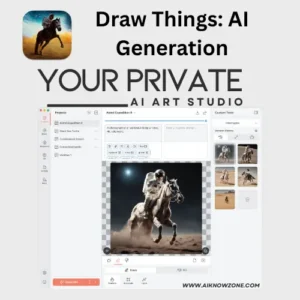
Okio
Explore Okio, the open-source AI audio platform. Transform music & voices with state-of-the-art AI models. Perfect for developers and creators!
Description
Okio AI Audio Platform: A Game-Changer for Sonic Innovation? 🎵
Alright, folks, let’s dive into something super cool: Okio, also known as Nendo, is an open-source AI audio platform aiming to shake up the music and sound creation world! 🚀. From what I’ve gathered, it’s designed as a professional AI audio tool suite geared towards developers who want to play around with sonic intelligence and generation. Forget clunky interfaces and complicated coding – Okio promises easy and fast application development, so you can bring your audio visions to life without pulling your hair out. The core of it all is the Nendo Platform, which seems to be the engine driving this AI-powered audio revolution. It’s not just about generating random sounds; it’s about crafting dynamic scores that adapt to real-time interactions, like in video games, or giving users the power to customize their audio experience. How awesome is that?! I’m excited to explore how Okio empowers creators and developers to explore uncharted territories in the world of sound.
Key Features and Benefits of Okio (Nendo)
So, what makes Okio stand out from the crowded field of AI audio tools? Here’s a breakdown of its killer features and the benefits they bring to the table:
- AI-Powered Analysis and Generator Tools: Craft dynamic scores that react to gameplay in real-time. Imagine music that evolves with the action on screen!
- State-of-the-Art AI Models for Music and Voice Generation: Generate high-quality music and voices using the latest AI technology. Think custom soundtracks and unique vocal performances.
- Audio Extraction and Transformation: Easily extract and transform audio elements, opening up new possibilities for sound design and manipulation. It lets you dissect audio and reshape it to your will.
- Open-Source and Free Forever (Nendo Core): The core of the platform is open-source, making it accessible to everyone, from hobbyists to professional developers. The price point of ‘free forever’ makes it super enticing!
- Extensible Plugin Architecture: Nendo’s architecture means that it’s adaptable with integrated essentials for audio processing and library management. It also enables you to expand its functionalities by adding plugins.
How Okio Works (Simplified)
Don’t let the “AI” part scare you; using Okio seems pretty straightforward. The Nendo platform is designed with ease of use in mind. While I haven’t personally tinkered with it yet (that’s next on my to-do list!), from what I’ve read, it involves diving into the Nendo core, which offers a user-friendly framework for building AI audio applications. You can leverage the pre-built AI models to generate music and voices, or get your hands dirty with audio analysis and transformation tools. The plugin architecture is key here, allowing you to extend the platform’s capabilities with additional features. The documentation and community support on GitHub should provide a solid foundation for getting started, even if you’re new to the world of AI audio. Ultimately, it’s about experimenting, exploring, and unleashing your creativity with the power of AI. The idea of crafting custom, dynamic audio experiences sounds incredibly exciting, and Okio seems to provide the tools to make it happen.
Real-World Use Cases for Okio
Okay, let’s get practical. How can you actually use Okio in the real world? Here are a few scenarios that have me buzzing with ideas:
- Dynamic Game Soundtracks: Imagine a game where the music adapts to the player’s actions, creating a truly immersive experience. When the player is in stealth mode, the music might become subtle and suspenseful. During intense combat, it could explode into a high-energy, adrenaline-pumping track. Okio can make this a reality.
- Personalized Music Creation: A musician can use Okio to generate unique instrumentals, vocal harmonies, or even entire songs based on specific parameters and desired styles. Think of it as an AI collaborator that helps you break through creative blocks and explore new sonic territories.
- Interactive Audio Installations: Artists could use Okio to create interactive audio installations that respond to the environment or the audience’s movements. For example, a soundscape that changes based on the weather or a musical composition that evolves as people interact with a physical space.
- Automated Audio Post-Production: Imagine automating tasks like noise reduction, audio enhancement, and dialogue editing in video production. Okio could streamline the post-production workflow and save valuable time for video editors and content creators.
Pros of Okio
- Open-Source and Free (Core): A huge win for accessibility and community-driven development.
- Powerful AI Audio Tools: State-of-the-art models for music generation, voice synthesis, and audio manipulation.
- Extensible Plugin Architecture: Easily expand functionality with custom plugins.
- Versatile Use Cases: Applicable to gaming, music creation, interactive art, and more.
Cons of using Okio
- Steep Learning Curve: While designed for ease of use, mastering AI audio tools still requires technical knowledge.
- Documentation May Need Expansion: As a relatively new platform, the documentation might not be as comprehensive as more established tools.
- Dependent on AI Model Quality: The quality of the generated audio is heavily reliant on the underlying AI models.
Okio Pricing
The Nendo core is open source and free to use. However, cloud access is available for a fee.
Conclusion
In conclusion, Okio has the potential to revolutionize the way we create and interact with audio. Its open-source nature, powerful AI tools, and extensible architecture make it a compelling platform for developers, musicians, artists, and anyone interested in exploring the frontiers of sonic innovation. If you’re ready to dive into the world of AI audio, Okio is definitely worth checking out! 🔥 I highly recommend any developer that wants to learn about AI or music creation to give it a try.


Reviews
There are no reviews yet.